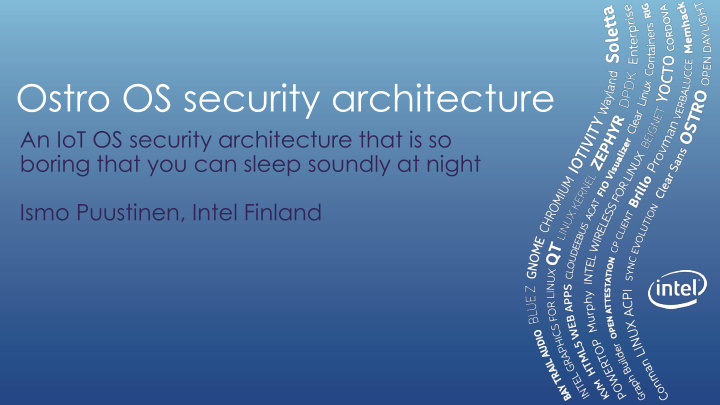



Ostro OS security architecture An IoT OS security architecture that is so boring that you can sleep soundly at night Ismo Puustinen, Intel Finland
What is Ostro OS? https://ostroproject.org IoT operating system, based on Yocto project Suitable for devices of various sizes Current HW targets: Galileo 2, Edison, NUC • Not meant to be an end-user operating system Ostro Project offers only pre-built development images • Ostro OS customers typically create IoT devices (ODMs, ...) • Rolling releases
Ostro OS security goals Scalable security Customers can decide which protection mechanisms to use Let customers to focus on things that add value Applications, cloud integration, ... Try to keep the end-user devices up-to-date Make it as painless as possible for customers to provide timely updates Secure against network threats Vulnerability mitigation
System updates System updates are pushed to end user devices using Clear Linux software update mechanism Stateless The devices with the same ”release number” are guaranteed to have the same versions of software – only configuration differs
Systemd Ostro OS security is heavily based on systemd System services Removed all non-necessary privileges Only system update service can write to root fs Run as non-root if possible (ambient capabilities in systemd 229) Permission checks based on Unix group membership Applications Service files generated from application manifests DAC or container technologies used to separate applications Not complete separation due to the nature of DAC, use containers if needed
Firewall Restrictive default firewall rules (IPv4 and IPv6) Iptables Services and applications need to open holes for themselves In the future go over to nftables Declarative - services can drop firewall configuration files
Secure boot UEFI secure boot – optional Protection against both offline and online attacks Kernel, initramfs and kernel command line in one signed UEFI blob IMA/EVM initialized from initramfs IMA hashes file content and stores the hash in security.ima xattr with the file Possible to sign the hash using a secret key (image build time) Kernel contains CA with the public key -> file content is secure EVM helps protect against offline attacks against the xattrs The xattrs are signed in security.evm with inode number (to prevent copying xattrs from one inode to another) Not possible to calculate EVM hashes offline, thus need to be signed using TPM
Mandatory Access Control Smack – optional More fine-grained permission handling than DAC Three-domain model ( System , User , _ ) inherited from Tizen
Filesystem layout / Conceptually read-only All services (except software update) will use systemd’s ProtectSystem=full to make root fs appear read-only /var Persistent data Kernel creates IMA/EVM creates hashes on- the-fly to provide some protection /tmp and /var/run tmpfs Deleted every shutdown /home Persistent data No IMA/EVM. Every application has its own home directory /etc Persistent data Ostro OS is (will be) stateless - /etc is empty before first boot. IMA/EVM hashing like /var.
Recommend
More recommend